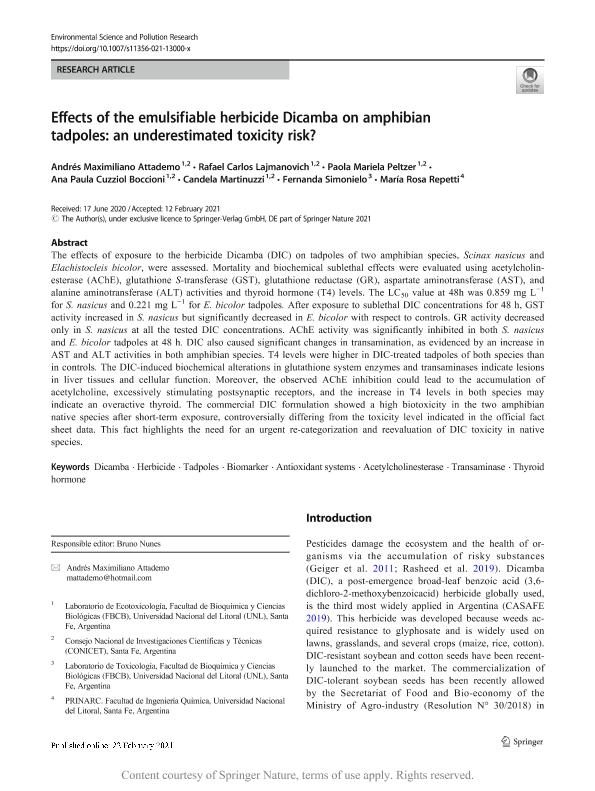Artículo
Effects of the emulsifiable herbicide Dicamba on amphibian tadpoles: an underestimated toxicity risk?
Attademo, Andres Maximiliano ; Lajmanovich, Rafael Carlos
; Lajmanovich, Rafael Carlos ; Peltzer, Paola
; Peltzer, Paola ; Cuzziol Boccioni, Ana Paula
; Cuzziol Boccioni, Ana Paula ; Martinuzzi, Candela Soledad
; Martinuzzi, Candela Soledad ; Simonielo, Fernanda; Repetti, María Rosa
; Simonielo, Fernanda; Repetti, María Rosa
 ; Lajmanovich, Rafael Carlos
; Lajmanovich, Rafael Carlos ; Peltzer, Paola
; Peltzer, Paola ; Cuzziol Boccioni, Ana Paula
; Cuzziol Boccioni, Ana Paula ; Martinuzzi, Candela Soledad
; Martinuzzi, Candela Soledad ; Simonielo, Fernanda; Repetti, María Rosa
; Simonielo, Fernanda; Repetti, María Rosa
Fecha de publicación:
02/2021
Editorial:
Springer Heidelberg
Revista:
Environmental Science and Pollution Research
ISSN:
0944-1344
Idioma:
Inglés
Tipo de recurso:
Artículo publicado
Clasificación temática:
Resumen
The effects of exposure to the herbicide Dicamba (DIC) on tadpoles of two amphibian species, Scinax nasicus and Elachistocleis bicolor, were assessed. Mortality and biochemical sublethal effects were evaluated using acetylcholinesterase (AChE), glutathione S-transferase (GST), glutathione reductase (GR), aspartate aminotransferase (AST), and alanine aminotransferase (ALT) activities and thyroid hormone (T4) levels. The LC50 value at 48h was 0.859 mg L−1 for S. nasicus and 0.221 mg L−1 for E. bicolor tadpoles. After exposure to sublethal DIC concentrations for 48 h, GST activity increased in S. nasicus but significantly decreased in E. bicolor with respect to controls. GR activity decreased only in S. nasicus at all the tested DIC concentrations. AChE activity was significantly inhibited in both S. nasicus and E. bicolor tadpoles at 48 h. DIC also caused significant changes in transamination, as evidenced by an increase in AST and ALT activities in both amphibian species. T4 levels were higher in DIC-treated tadpoles of both species than in controls. The DIC-induced biochemical alterations in glutathione system enzymes and transaminases indicate lesions in liver tissues and cellular function. Moreover, the observed AChE inhibition could lead to the accumulation of acetylcholine, excessively stimulating postsynaptic receptors, and the increase in T4 levels in both species may indicate an overactive thyroid. The commercial DIC formulation showed a high biotoxicity in the two amphibian native species after short-term exposure, controversially differing from the toxicity level indicated in the official fact sheet data. This fact highlights the need for an urgent re-categorization and reevaluation of DIC toxicity in native species.
Archivos asociados
Licencia
Identificadores
Colecciones
Articulos(CCT - SANTA FE)
Articulos de CTRO.CIENTIFICO TECNOL.CONICET - SANTA FE
Articulos de CTRO.CIENTIFICO TECNOL.CONICET - SANTA FE
Citación
Attademo, Andres Maximiliano; Lajmanovich, Rafael Carlos; Peltzer, Paola; Cuzziol Boccioni, Ana Paula; Martinuzzi, Candela Soledad; et al.; Effects of the emulsifiable herbicide Dicamba on amphibian tadpoles: an underestimated toxicity risk?; Springer Heidelberg; Environmental Science and Pollution Research; 28; 24; 2-2021; 31962-31974
Compartir
Altmétricas



